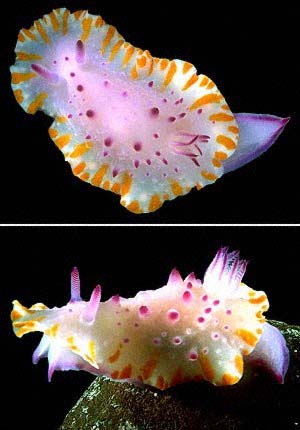
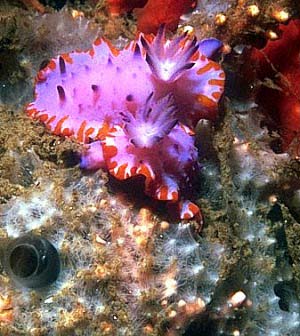
Mexichromis macropus
Rudman, 1983
Order: NUDIBRANCHIA
Suborder: DORIDINA
Family: Chromodorididae
DISTRIBUTION
Found throughout temperate and subtropical Australia [SW Western Australia, South Australia, Tasmania, Victoria, NSW, southern Queensland].
PHOTO
UPPER: Sisters Is, NW of Wynyard, northern Tasmania, May 1990. CENTRE: as above, showing tentacular anterior foot corners typical of Mexichromis. PHOTOS: Bill Rudman.
LOWER: Busselton Jetty, southern Western Australia. Feeding on sponge. PHOTO: Clay Bryce.
RELATED TOPIC
Ventral view showing Mantle glands
Mexichromis macropus differs from other Australian species of Mexichromis in having a mantle border consisting of radially arranged orange or yellow-orange stripes rather than spots or longitudinal lines. The dorsum ranges from translucent white to purple and has scattered pointed papillae tipped in purple. Like, to Mexichromis festiva and to Mexichromis mariei it has often been found with a bluish grey sponge, tentatively identified as a species of Dysidea.
References:
• Rudman, W.B. (1983) The Chromodorididae (Opisthobranchia: Mollusca) of the Indo-West Pacific: Chromodoris splendida, C. aspersa and Hypselodoris placida colour groups. Zoological Journal of the Linnean Society 78: 105-173.
• Rudman, W.B. (1984) The Chromodorididae (Opisthobranchia: Mollusca) of the Indo-West Pacific: a review of the genera. Zoological Journal of the Linnean Society 81: 115-273.
Rudman, W.B., 1999 (January 16) Mexichromis macropus Rudman, 1983. [In] Sea Slug Forum. Australian Museum, Sydney. Available from http://www.seaslugforum.net/find/meximacr
Related messages
Re: Mexichromis macropus found sthn Queensland
March 8, 2010
From: Leanne and David Atkinson

Concerning message #22143:
Dear Bill,
Re:Gary Cobb's message about Mexichromis macropus feeding. We found these Mexichromis macropus on a sponge on a leg of Rapid Bay Jetty. At the time we photographed them from different angles trying to see if they were feeding. When we looked at the photos after the dive we noticed some eggs beside one and wondered if it was laying eggs. We can't actually see the oviduct but thought they might be of interest anyway. You don't seem to have any photos of their eggs in the messages or fact sheet and we wondered if their egg colour etc had been recorded.
Locality: Rapid Bay Jetty, Fleurieu Peninsula, 8 metres, South Australia, Southern Ocean , 16 February 2010, Sandy bottomw with sponge, ascidian and seaweed growth extending up Jetty legs. Length: approximately 20 mm. Photographer: Leanne & David Atkinson.
Regards,
Leanne & David Atkinson
atk@hunterlink.net.au
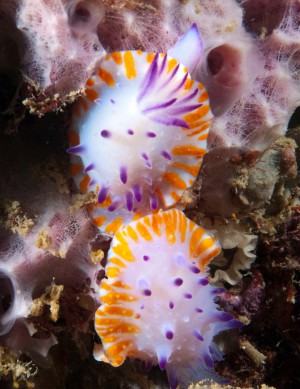


Dear Leanne and David,
Thanks for the record. These could well be the eggs of M. macropus. I am pretty sure we don't have a record of its egg ribbon, but the one in your photo does have similarities to those of M. festiva [see Fact Sheet] and M. multituberculata [ see messages #8655, #6273].
Its presence on this purple sponge is also valuable. It is a dysideid of the genus Euryspongia and appears to be the favourite food choice of M. macropus.
Best wishes,
Bill Rudman
Mexichromis macropus found sthn Queensland
January 15, 2009
From: Gary Cobb
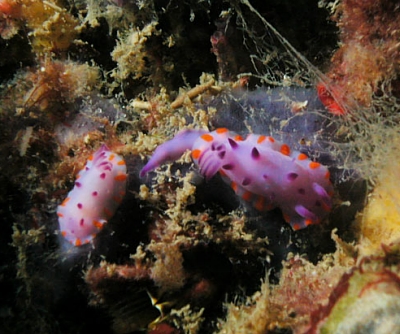
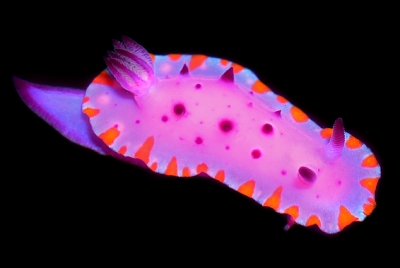
Hi Bill and Everyone!
Please find photos of the ever-so-beautiful Mexichromis macropus found here between Noosa and Moreton Island. This species has been found about 20 times in 6 years. The photos attached are from a double dive I did on the HMAS Brisbane wreck. 6 animals were found and one was quite large.
This is the first time I have seen this species on the wreck. I assume the right food source must be growing on the wreck now. On previous dives I have seen Hyselodoris jacksoni as quite common, but now there are none to be seen. Another species that was seen 4 times on the same dives was Tambja morosa.
Locality: Mooloolaba, Sunshine Coast, 18 m, Queensland, Australia, Pacific Ocean, 08 January 2009, Subtidal. Length: 15-30 mm. Photographer: Gary Cobb.
Cheers
Gary
gary@nudibranch.com.au
Cobb, G.C., 2009 (Jan 15) Mexichromis macropus found sthn Queensland. [Message in] Sea Slug Forum. Australian Museum, Sydney. Available from http://www.seaslugforum.net/find/22143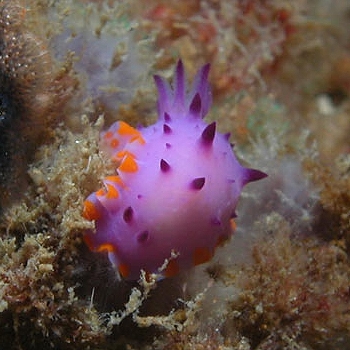
Dear Gary,
The right food source you wonder about is indeed present. It is the bluish - purplish sponge the animals are sitting on. It is a species of Euryspongia which appears to be the main - perhaps only - food choice of Mexichromis macropus.
In the black background photo we can see the large white spherical glands embedded in the mantle skirt around the posterior end of the mantle, so typical of species of Mexichromis. These white sacs store distasteful molecules from its food sponge which it uses to deter potential predators. As different groups of sponges have different anti-feedant molecules, we can get clues to the likely food of sponge-feeding nudibranchs by investigating the molecules the nudibranchs have stored in their mantle.
Best wishes,
Bill Rudman
Orange-Barred Mexichromis - Fremantle, WA
March 1, 2007
From: Brent Murdoch
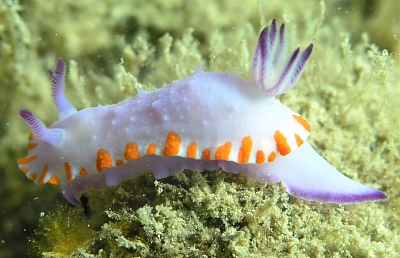
Hi,
I think I have identified this one correctly. The reference I have has some dark spots on the top of the body, but this one does not.
Locality: Fremantle, Swan River, 4.5, Western Australia, Australia, Indian Ocean, 03 February 2007, Sand / Weed. Length: 35 mm. Photographer: Brent Murdoch.
Brent Murdoch.
brent@murdoch.id.au
Murdoch, B.D., 2007 (Mar 1) Orange-Barred Mexichromis - Fremantle, WA. [Message in] Sea Slug Forum. Australian Museum, Sydney. Available from http://www.seaslugforum.net/find/19514Dear Brent,
It is unusual to find animals without the dark purple spots or purple-tipped papillae, but they do occur.
As you will see on my Fact Sheet on common names, I am not a great supporter of their use. This is quite a good example why. I named this species Mexichromis macropus because the first specimens I had of it were from Kangaroo Island in South Australia and Macropus is the scientific name for the kangaroo genus. I know you are just following what is in your book, but if this species really needs a common name wouldn't Kangaroo Island Mexichromis be more true to its real name? But why bother? Mexichromis macropus is shorter than either Kangaroo Island Mexichromis or Orange-barred Mexichromis. Many book publishers think 'common' people can't use scientific names. If so, surely it is contradictory to have the 'scientific' name Mexichromis in the common name? Please use Mexichromis macropus - its shorter, it is unique to this species, and it can be understood anywhere in the world.
Best wishes,
Bill Rudman
Mexichromis macropus from Port Phillip Bay, Australia
August 26, 2006
From: Perry Davis
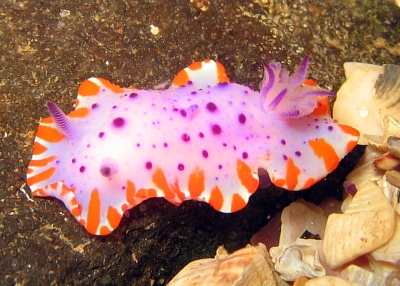
Dear Bill,
I found a pair of nudi's in Port Phillip Bay which I can't identify.
Locality: Port Phillip Bay, 13-15 metres, Victoria, Australia, 13 July 2006, silty bottom. Length: 25-35 mm. Photographer: Perry A Davis.
Regards
Perry Davis
perryadavis@bigpond.com
Davis, P.A., 2006 (Aug 26) Mexichromis macropus from Port Phillip Bay, Australia. [Message in] Sea Slug Forum. Australian Museum, Sydney. Available from http://www.seaslugforum.net/find/17577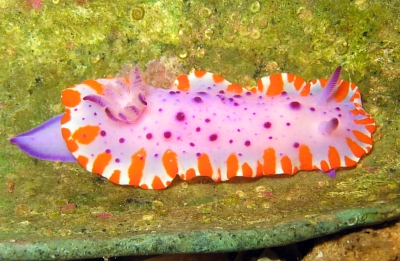
Dear Perry,
This beautiful chromodorid is Mexichromis macropus. The origin of its name is quite interesting. Mexichromis got its name because the first species in the genus was a 'chromodorid from Mexico'. And macropus is the genus name for kangaroos, and this species was first found at Kangaroo Island in South Australia
Best wishes,
Bill Rudman
Mexichromis macropus from Western Australia
August 9, 2005
From: Mick Tait
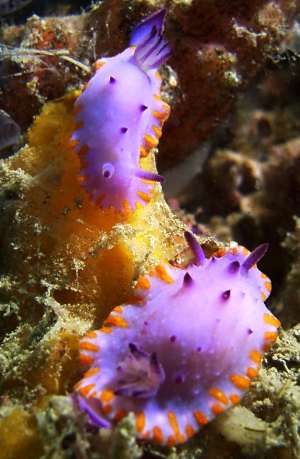
Photographed on the Bell Beach Wreck Trail - Rockingham. There was a group of three located in a depression on the side of the "Target " wreck. Not seen this species on the Wreck trail before. Not common.
Polycera hedgpethi is still dominating this dive site by numbers. They are everywhere! [see message #14235 ]
Water Temp now 15-deg C in Cockburn Sound.
Locality: Bell Beach Rockingham, Cockburn Sound, Western Australia. Depth: 9 m. Length: 35 mm. 30 July 05. Side of the "Target" wreck. Photographer: Mick Tait
Mick Tait
mick@bluesphere.com.au
Tait, M, 2005 (Aug 9) Mexichromis macropus from Western Australia. [Message in] Sea Slug Forum. Australian Museum, Sydney. Available from http://www.seaslugforum.net/find/14500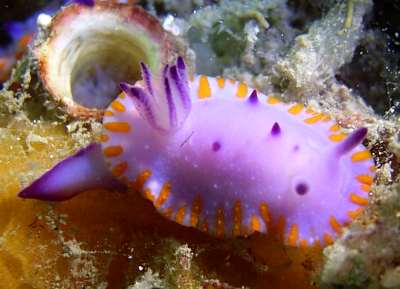
Thanks Mick,
Bill Rudman
Mexichromis macropus from South Australia
January 26, 2005
From: Carl Mooney
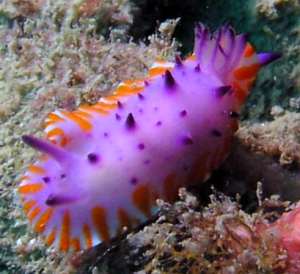
Hi,
I have another one to identify.
Locality: O'Sullivan Beach. South Australia, Gulf St Vincent.
Depth: 30 metres. Length: 20 mm. 9 January 2005, on wreck
Photographer: Carl Mooney
Regards,
Carl Mooney
selenite@bigpond.net.au
Mooney, C.H., 2005 (Jan 26) Mexichromis macropus from South Australia. [Message in] Sea Slug Forum. Australian Museum, Sydney. Available from http://www.seaslugforum.net/find/12929Dear Carl,
This is Mexichromis macropus. This species was named from specimens which were from Kangaroo Island in South Australia. The name macropus is from the scientific name for the kangaroo.
Best wishes,
Bill Rudman
Mexichromis macropus from Ningaloo Reef
January 1, 2005
From: Kristin Anderson
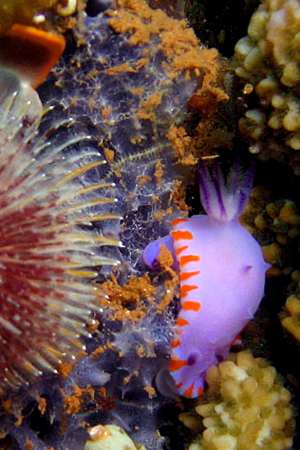
Dear Bill,
Is this a juvenile of Mexichromis macropus?
Locality: Exmouth Gulf, Western Australia, Indian Ocean
Depth: 9 m. Length: approx 10 mm. 28 December 2004
silt bottom; on coral head covered with Christmas Tree worms and flat sponges. Photographer: Kristin Anderson
Kristin Anderson
kristin@exmouthdiving.com.au
Anderson, KJ, 2005 (Jan 1) Mexichromis macropus from Ningaloo Reef. [Message in] Sea Slug Forum. Australian Museum, Sydney. Available from http://www.seaslugforum.net/find/12867Dear Kristin,
Yes this is Mexichromis macropus, and the bluish-purple sponge it is on is its preferred food sponge. With the help of a sponge expert, I am at present preparing a list identifying many of the sponges illustrated in the Forum.
Best wishes,
Bill Rudman
Mexichromis macropus from Rapid Bay Jetty
February 21, 2004
From: Dave Harasti
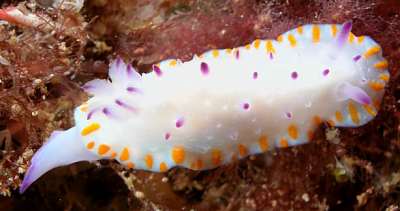
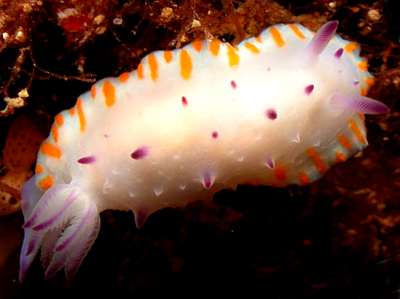
Hi Bill,
I'm having some difficulty identifying this nudibranch that I found under Rapid Bay Jetty [Fleurieu Peninsula, South Australia] in January 2004. Depth was about 4 metres and water temp was 20 degrees. This animal was about 3cm long.
I thought it could be the species Chromodoris ambiguus. Is this identification correct?
Regards,
Dave
diving@webone.com.au
Harasti, D., 2004 (Feb 21) Mexichromis macropus from Rapid Bay Jetty. [Message in] Sea Slug Forum. Australian Museum, Sydney. Available from http://www.seaslugforum.net/find/12272Dear Dave,
This is Mexichromis macropus which is characterised by the radial orange lines around the mantle edge and the pointed papillae, often tipped in purple. I named this species macropus after the genus name for the kangaroo, as the first specimens I had came from Kangaroo Island in South Australia.
Best wishes
Bill Rudman
Mexichromis macropus from Sydney
March 28, 2001
From: Erik Schloegl
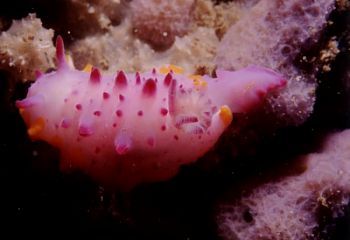
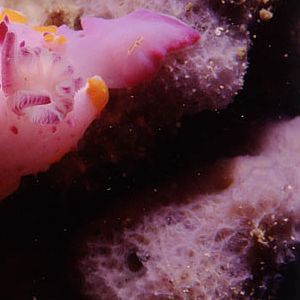
Dear Bill,
Here's a nudibranch which I think is Mexichromis macropus, though it also looks similar to one of the pictures you have of Mexichromis mariei - it's unclear to me whether this specimen can be considered to have "a border of radially arranged orange or yellow lines", as you write.
The photo was taken at Ship Rock, Port Hacking, Sydney, New South Wales, on 26 March 1998, at a depth of 14m on a rock wall covered with invertebrate growth. It was about 2-3cm long. Unfortunately it is the only photo I took so the mantle edge isn't that clear
Best wishes,
Erik
ERik.Schlogl@uts.edu.au
Schloegl, E., 2001 (Mar 28) Mexichromis macropus from Sydney. [Message in] Sea Slug Forum. Australian Museum, Sydney. Available from http://www.seaslugforum.net/find/4032Dear Erik,
Thanks for the M. macropus photo. In general the border in M. festiva is either a solid or broken line around the edge, while in M. macropus there are usually a series of short yellowish lines lying at right-angles to the edge. M. mariei, can look a bit like your animal but the purple border to the foot is submarginal. However, if you look at the messages concerning the various 'species' of Mexichromis in the Indo-Pacific you will see I am growing more tentative as time passes. Whatever it is, it is a nice photo of its favorite food sponge.
Cheers,
Bill Rudman.
